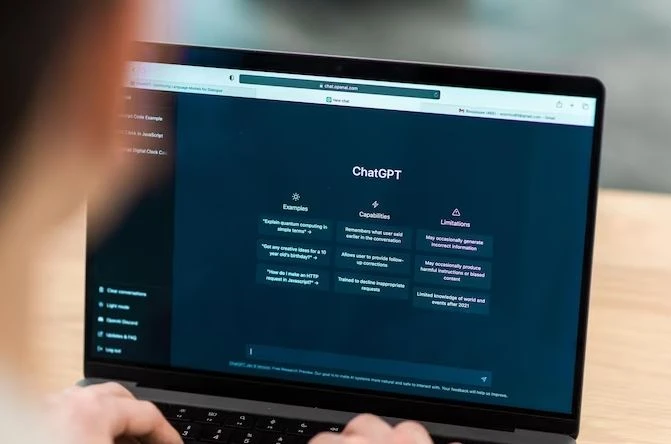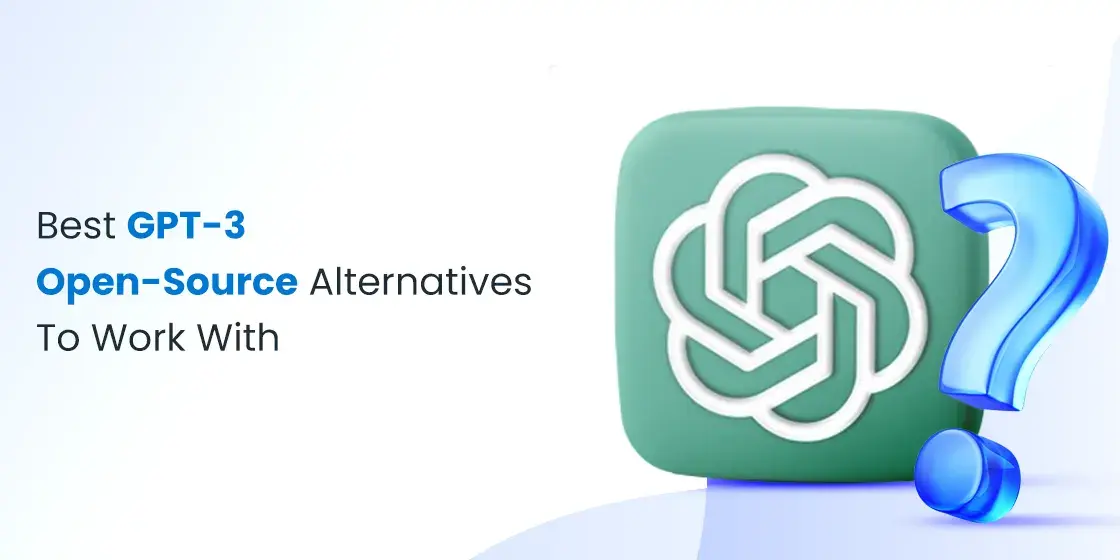Table of Content
Know About the Best GPT3 Apps Currently Available in the Market
The arrival of ChatGPT has opened new doors of discussion related to the rising capabilities of AI. It is indeed a powerful application that sounds exactly like a human. Using ChatGPT, you can write content for almost everything, ranging from blogs to whitepapers and more others. This trend has literally started to gain attention, as bunch of other platforms are also joining the race. Besides ChatGPT, there are some other GPT3 open-source alternatives also recently introduced in the market to accommodate this demand. These apps are really good, and they can also generate all types of content as per the given requirements.
It should be noted that applications like ChatGPT or Bard are completely built using AI algorithms. This means that these apps understand machine language better than the human conversation. However, the NLP technology used in these apps help to cover that gap as well. It makes sure to provide human-like interaction whenever something is asked from the platform. This feature is also present in other GPT3 open-source alternatives, as they are also built using the same methodology. This is also a major fact that has amazed many people, as no one was expecting such human-friendly tone from any digital system.
Due to this, the popularity of ChatGPT and other GPT3 open-source alternatives are continuously rising. Many people are also using them for custom software development, as they can also write programing codes for different app functions. If you also want to know the process and working methodology of these interactive applications, read this blog in detail. It will define how this new technology works and what type of other GPT3 open-source alternatives are available in the market.
So, lets start by understanding the basics of GPT-3, as that will let us know how this technology works and what type of models it uses to provide such accurate answers. Let’s take a look at it below.
What is GPT-3?

GPT-3 is the largest language model ever created in the world. It is built by OpenAI in 2020, one year before the launch of ChatGPT. GPT-3 (Generative Pre-Trained Transformer 3) is basically an unsupervised language model that helps to compute and understand tons of data quickly. Not just that, but it has got the instincts of NLP that allows the app to communicate with any human in a super-friendly conversational tone. This is what makes GPT-3 a complete new technology that allows machines to understand and communicate easily in a human-friendly language.
As per the reports, GPT-3 contains a minimum of 175 billion data parameters. This is certainly a gigantic number, showcasing a great capacity of the technology to read and interpret data. It should be noted here that this huge data set is chosen to fulfil a specific purpose i.e. to understand all types of user data. This is the core reason why GPT-3 is considered very powerful in providing answers relating to every question. It can provide answers by taking real-time decisions, which is indeed the main quality of this great AI-powered technology.
Emergence of ChatGPT

Built purely on the language model of GPT-3, ChatGPT is one of the best AI apps to generate quality content. It is powered with the algorithms of NLP, meaning that ChatGPT can easily understand human language. That is what makes this platform very different from others. It is not a content spin app that just rephrases the content, instead, ChatGPT is a whole content hub in its own. You can use it to write different types of content, ranging from blogs, SOW documents, thesis and more others. This is indeed an amazing capability that is not found in conventional content writing apps.
Since the arrival of ChatGPT in late 2022, there has been a sharp rise in the development of different GPT3 open-source alternatives. It can be easily understood that ChatGPT has started this trend, which will continue to grow more in the coming years. Obviously, many people are simply stunned with this level of proficiency shown by a AI platform. They simply love to use ChatGPT to quickly write different types of content, as it is easy, fast and accurate most of the times.
However, it should be noted that ChatGPT has got some limitations. Since it is a complete AI based platform, it often lacks in understanding the emotion or feelings of humans. This is where AI engineers and currently working, in fact some new GPT3 open-source alternatives are coming up with better answers.
Best GPT3 Open-Source Alternatives You Must Need to Try

When it comes to write quality content using the AI technology, ChatGPT is currently ruling the charts. It has got impeccable perfection in generating content in different tons and languages as per the given demands. However, it has also started to get some competition as well.
Right now, you can also find some GPT3 open-source alternatives available in the market. These apps are built following the same methodology, hence they are pretty good in providing to-the-solutions as asked in questions. If you do not know which GPT3 open-source alternatives should be used to write blogs, reports, etc., take a look at the list given below.
BLOOM
BLOOM is undoubtedly the best contender of ChatGPT right now in terms of generating quality content using the AI technology. It is developed by BigScience with approx. 176 billion data parameters. This number surpasses the count of parameters used in ChatGPT, which is also nearly around 175 billion data sets. This app is developed at the supercomputing center of French National Center for Scientific Research. Though it came after the launch of ChatGPT, but is still considered a very capable platform having the highest quality of AI technology.
BLOOM is one of those platforms that is officially funded by the French government. Moreover, it involved over 1000 volunteer researchers from different parts of Europe. This defines the potential of the project, as it included different parties in the overall development. As a result, it is a complete platform where you can get answers in more than 40 languages. Though its primary language is English, but that can be changed as per the needed functional requirements.
GPT-NeoX
Next up, we have got GPT-NeoX in the list of best GPT3 open-source alternatives currently available around. It is also an advanced platform that is built on the strong bases of natural language processing (NLP) models. It is quite capable in providing detailed answers using the data set of 20 billion parameters. This is what makes GPT-NeoX a decent platform for writers, as well as researchers. They can use it for a variety of purposes, as the platform will always give quality results according to the questions given to its AI processors.
This language model is developed by the researchers of EleutherAI. It is a renowned non-profit artificial intelligence research group based in New York. The first version of NeoX was not that effective, as it was built on the smaller versions of the model including GPT-J6B and GPT-Neo. However, the arrival of this new version changed the perspective, making GPT-NeoX one of the best open-source alternatives currently available in the market.
OPT-175B
Developed by Meta, OPT-175B is a powerful language model capable of computing and processing all types of data. It is often termed on par with ChatGPT because the platform is also trained on the huge data set of 175 billion parameters. This makes the app extremely helpful for community engagement and research use cases. Currently, it is released under the noncommercial license, meaning that the app is built for general public usage. From students to researchers, it is a good option to go with, provided the data is fed to the system correctly.
The good thing about OPT-175B is that it is trained using Meta’s open-source Fully Sharded Data Parallel (FSDP). It is a specialized type of model that shards parameters, optimizer states and gradients across DDP ranks. This is quite an advanced mechanism that makes OPT-175B a powerful AI-based platform for data processing. It is also touted to be energy efficient, meaning that it gives less carbon footprint as compared to GPT-3.
Chinchilla
Chinchilla is relatively a new name in the rising field of AI language processors, but it has already started to show promising signs of dominance. It is also called GPT-3 killer, because the platform offers similar language processing functionalities as shown in ChatGPT. Built on 70 billion parameters, Chinchilla is also versatile and innovative in handling all types of data queries. As per the recent survey, it has outclassed many other language processing platforms like Gopher, OPT and others in several downstream evaluation tasks.
Keeping this amazing result in mind, Chinchilla has started to get industry attention. It requires very less computing power, which also means that the platform is energy efficient. All of these qualities make Chinchilla a top platform to generate AI-based content offering great accuracy and perfection.
AlexaTM
When it comes to keeping pace with technology, Amazon never stays behind anyone in the race. This case is also followed in the development of large language models, as AlexaTM is Amazon’s answer to generate AI-based informative content. It is a 20 billion parameter sequence-to-sequence transformer model that was trained on a mixture of Common Crawl (mC4) and Wikipedia data across 12 languages.
AlexaTM can be used for a variety of tasks, including machine translation, text summarization, and question answering. One of the key features of AlexaTM is its ability to perform few-shot learning. This means that it can learn to perform a new task with only a few examples. This makes it well-suited for tasks where there is limited data available, such as machine translation for low-resource languages.
Gopher
Gopher is a large language model (LLM) developed by DeepMind. It has 280 billion parameters, which makes it larger than OpenAI’s GPT-3 and Microsoft’s Megatron-Turing NLG. Gopher was trained on a massive dataset of text and code, and it can perform a variety of tasks, including answering questions, generating text, translating languages and more others. All of these features make this platform a good alternative to ChatGPT and other AI content platforms currently working around.
Gopher has been shown to be more accurate than other LLMs on a variety of tasks, particularly those that require knowledge of specialized subjects. For example, Gopher was able to answer questions about science and the humanities more accurately than GPT-3. It is still under development, but it has the potential to be a powerful tool for a variety of applications. It could be used to improve search engines, develop more natural language interfaces, and create new forms of creative content.
GLaM
Developed by Google AI, GLaM GPT is a large language model (LLM) that allows you to generate quality AI-based content. It has 1.2 trillion parameters, which makes it approximately 7 times larger than GPT-3. GLaM GPT is a mixture of experts (MoE) model, which means that it is made up of a number of smaller submodels that are each specialized for different tasks. This makes it more efficient and scalable than traditional LLMs, which are typically made up of a single large model.
GLaM GPT has been shown to outperform GPT-3 on a variety of tasks, including natural language understanding (NLU) and natural language generation (NLG). It is also more efficient in terms of energy consumption and computational resources.
LaMDA
LaMDA stands for Language Model for Dialogue Applications. It is a large language model (LLM) developed by Google AI. LaMDA was first announced in 2021 and is still under development. It is trained on a massive dataset of text and code, and it can perform a variety of tasks, including translating languages, writing different kinds of creative content, reasoning/making predictions and more other similar content based tasks.
LaMDA was first announced in 2021, and it has been the subject of much attention, particularly after a Google engineer, Blake Lemoine, claimed that LaMDA had become sentient. However, Google has denied these claims, stating that LaMDA is simply a very good language model that is able to generate human-like text.
Frequently Asked Questions
| What is ChatGPT? ChatGPT is a large language model chatbot developed by OpenAI. It is trained on a massive dataset of text and code, so it can generate human-like text in response to a variety of prompts and questions. |
| Which are the best GPT3 open-source alternatives currently available? The list of GPT3 apps are continuously growing, and there are plenty of apps currently available for general public usage. It includes many names such as BLOOM, Chinchilla, LaMDA, OPT-175B and more others. |
| Why GPT3 apps are becoming popular in the world? GPT3 apps are becoming popular in the world because they offer a variety of benefits. These apps are able to generate human-like text that is often indistinguishable from real text. Furthermore, GPT3 apps can be scaled to handle large amounts of data which makes them extremely beneficial for research organizations. |
Read Interesting Articles:
Final Words
That takes us to the end of this blog in which we have discussed some of the best GPT3 open-source alternatives available in the market. These platforms are getting huge attention these days, as people are simply loving the idea to write content using powerful AI apps. The name of ChatGPT is doing more rounds in the market, however, you also need to know some other GPT3 open-source alternatives as well. In this blog, we have defined some of them, so that you can know that the competition in the market is growing and multiple new platforms are being launched rapidly.
Meanwhile, if you are looking for a digital agency that can help you to develop quality mobile and web apps, give us a call today. We have got plenty of experience, and our experts can help you to develop all types of software apps efficiently.
Empower your digital initiatives with BariTechSol, a premier custom software development company. Our skilled team tailors cutting-edge solutions to your unique needs. Elevate your tech experience and stay ahead in the digital realm. Partner with BaritechSol and code the success of your next big idea.


